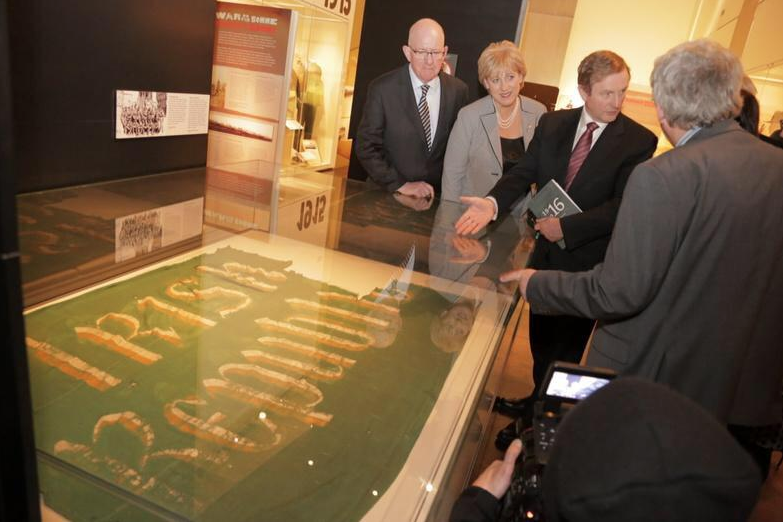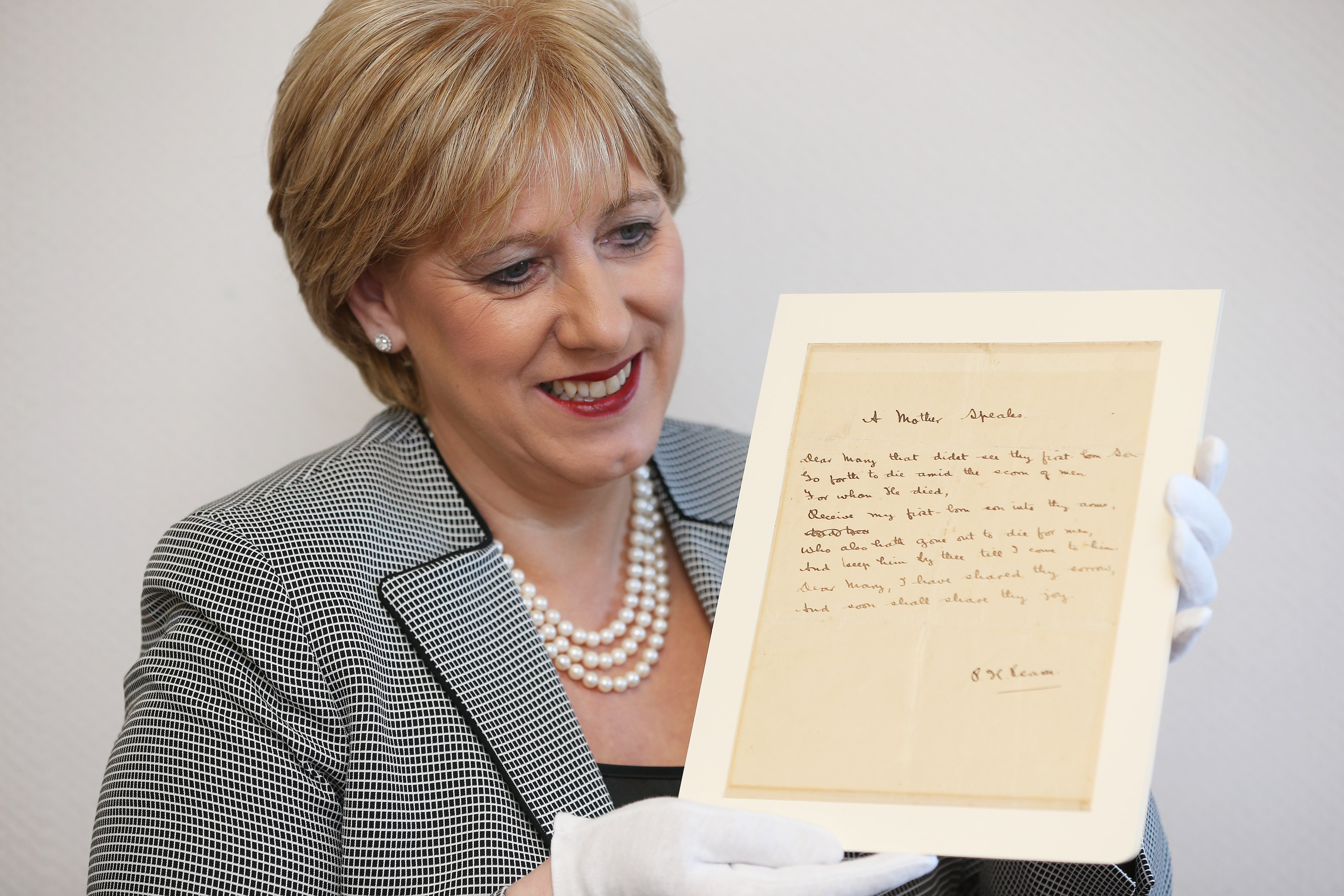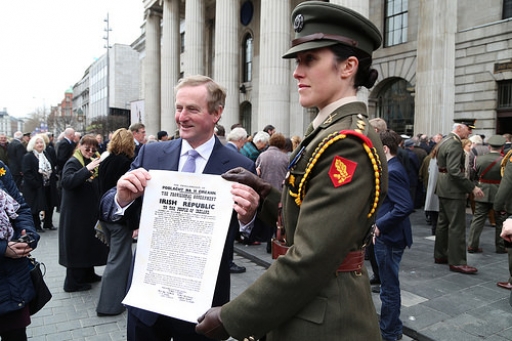A year long programme of events to mark the anniversary of 1916 – a seminal year in Ireland’s history – has been announced by Irish Taoiseach (Prime Minister), Enda Kenny.
Amidst the chaos of the First World War, 1916 saw a small uprising by republicans in Dublin take hold of the country. The 1916 Easter Rising set off a series of events – the War of Independence, the Irish Civil War and the Partition of Ireland – that ultimately lead to establishment of the Irish Free State in 1922.
The Ireland 2016 Centenary Programme is led by Heather Humphreys, the Minister for Arts, Heritage and the Gaeltacht. It calls on the people of Ireland and the Irish Diaspora around the world to remember those that fought for independence, and to reflect on the legacy of the last 100 years.

The following is part of the press release issued by the Irish Department of Arts, Heritage and the Gaeltacht:
“To mark the centenary of 1916, the Government has provided €22million in 2015 for a number of major flagship capital projects, which will be completed by Easter 2016.
The programme includes seven strands; State Ceremonial; Historical Reflection; An Teanga Bheo/The Living Language; Youth and Imagination; Cultural Expression; Community Participation; Global and Diaspora.
Highlights include:
* A major exhibition of 1916 archival material at the National Museum of Ireland, Collins Barracks, Dublin.
* ‘Proclamation Day’, which will be held in all schools on March 15th 2016.
* The National Flag and a copy of the Proclamation will be delivered to every school in the country.
* A series of State commemorative events, including a parade from Dublin Castle to Parnell Square on Easter Sunday 2016 and a special State Reception for relatives.
* Seven new public projects at the GPO, Kilmainham Gaol, Pearse’s Cottage, the Military Archives and other sites.
* A multi-location public event, to be broadcast on television on Easter Monday 2016, telling the story of Ireland, through music, dance, drama and song.
* A series of conferences on ‘1916 through our universities.’
* Cultural events around the globe, to be co-ordinated through Irish embassies and Culture Ireland, including cultural festivals in Washington and London.”
Speaking at the launch of Ireland 2016 in Collins Barracks on March 31st 2015, Taoiseach Enda Kenny said: “There are some moments in history when a seed is sown and the old order changes forever.
“Easter 1916 was a moment when Irish nationalism joined forces with a revolutionary cultural and language movement to forge an irresistible campaign towards self-determination.
“It is important that the Irish people have the opportunity to come together to celebrate and have pride in Ireland’s independence, and to honour those who gave their lives so that the dream of self-determination could become a reality”.

Minister for Foreign Affairs & Trade Charlie Flanagan; Minister for Arts, Heritage and the Gaeltacht Heather Humphreys; and Taoiseach Enda Kenny at the Ireland 2016 launch at Collins Barracks, Dublin (Image: DAHG Press Office, Merrion Street)
State Events
Official state ceremonies will be held throughout the year including parades, public lecture series and state receptions at key locations associated with the Easter Rising and 1916.
There will be events held to commemorate the role women played during 1916, as well as an event led by the relatives of those involved in the Easter Rising one hundred years ago.
The National Museum of Ireland and National Library of Ireland will both host comprehensive exhibitions and educational events throughout the year and will digitise over 20,000 files relating to the Rising.
The National Archives of Ireland will unveil new archives including the 1916 court-martial files and the Dublin City Metropolitan Police surveillance files.
Education and Culture
The educational strand of Ireland 2016 will aim to involve young people – from primary to university level – in the commemorative programme.
As well as the ‘Proclamation for a New Generation’ scheme, which encourages children to create a new version of the proclamation that reflects their own values, the state will be introducing a new Leaving Certificate (A-Level) subject, Politics and Society, in schools across the country.
Irish Universities will be participating in a national conference to debate the legacy and impact of the Rising.
The Arts Council has curated an extensive programme of concerts and touring theatre programmes based around the Ireland 2016 Centenary. The National Concert Hall will hold a series of seven concerts over Easter Week 2016, each reflecting key themes of the Proclamation.
The Abbey Theatre will also be staging productions of classic Irish plays, as well as commissioning works from young playwrights.

Minister for Arts, Heritage and the Gaeltacht Heather Humphreys holding a letter from Pádraig Pearse, part of the National Museum of Ireland’s 1916 collection. (Image: DAHG Press Office)
Language and the Global Community
An Teanga Bheo – The Living Language – is a central strand to Ireland 2016 and aims to promote the Irish Language in a diverse series of lectures, arts events and learning resources.
Local authorities, the Gaelic Athletic Association (GAA) and the Heritage Council are working to encourage widespread participation in the Centenary programme at every level of Irish society.
Ireland 2016 will also be working with Irish Embassies across the world to organise cultural events and exhibitions to commemorate 1916 and the Irish Diaspora.
This will include a three-week festival, ‘Proclaiming Ireland’, to be held in Washington, DC in May and June of 2016.
At the Ireland 2016 launch in Collins Barracks, Minister of State Aodhán Ó Ríordáin spoke on how the Centenary Programme will bring about a new and expansive sense of Irish identity:
“The Ireland 2016 Centenary Programme we are announcing tonight is only part of the story. So many families have a history of relatives serving in different uniforms during this period that we prepare to commemorate.
“Now we have an opportunity to re-examine that history; those differences; and to appropriately commemorate all those who were involved in this critical time in our nation’s history.
“It is also a time to reflect on the Republic that we live in today, and to acknowledge the people who have come from abroad to live here. These new communities enrich our society and it is crucial that we use this period of reflection to reiterate that this Republic belongs to everyone.”
The Ireland 2016 Centenary Programme will begin with a re-enactment of the funeral of O’Donovan Rossa on August 1st 2015 at Glasnevin Cemetery in Dublin.
Rossa was a leader of the Irish Republican Brotherhood whose burial in 1915 garnered significant support for the IRB and Irish Volunteers in Ireland.
It was here that Pádraig Pearse, one of the leaders of the Easter Rising, gave a graveside speech that has become one of the most famous of the Irish Independence movement.
For more information on the full programme of events, visit the Ireland 2016 website.
Or follow Ireland 2016 on Facebook and Twitter.
Watch a video preview of the Ireland 2016 Centenary Programme here.
Source: Irish Government, Department of Arts, Heritage and the Gaeltacht.
Photos courtesy of Department of Arts, Heritage and the Gaeltacht Press Office, Ireland.ie, Merrion Street.
Posted by: Éadaoin Hegarty, Centenary News
